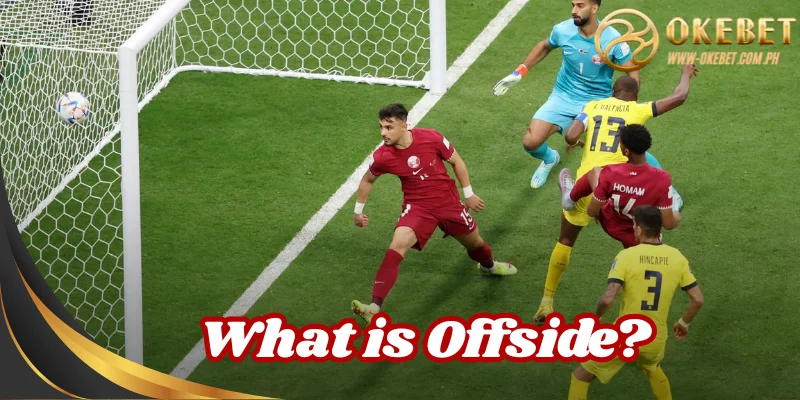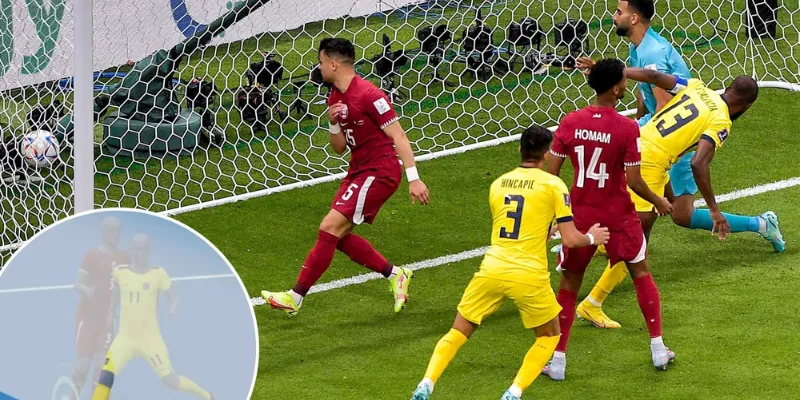Offside is one of the most frequently used concepts in contemporary football. This is a law issued by FIFA – the planet’s largest football federation – aimed at bringing fairness to matches.
So, what does this law stipulate? What situations are not considered offside offences in the beautiful game?
Join Okebet in the following article for more detailed information.
Detailed Explanation of the Term Offside

This is a concept commonly encountered in football matches. Simply put, an offside offence occurs when a player on the attacking team receives the ball while positioned ahead of the second-to-last opponent (usually the last outfield defender, excluding the goalkeeper).
According to the latest laws from the World Football Federation (FIFA), if any part of the player’s body permitted to play the ball (head, body, feet) is past the second-to-last opponent when the ball is played by a teammate, that player is in an offside position. To be penalized for an offside offence, the following conditions must generally be met:
- The player must be in the opponent’s half of the field.
- The attacking player must be nearer to the opponent’s goal line than both the ball and the second-to-last opponent.
- The player in the offside position must become involved in active play (interfering with play, interfering with an opponent, or gaining an advantage by being in that position).
- The player is positioned in the direction of attack towards the opponent’s goal.
Exploring FIFA’s Offside Law
For those unaware, those Law is also known as Law 11 in the Laws of the Game issued by FIFA. This law ensures fairness, equality, and limits invalid play situations during matches.
With this regulation, clubs and players contribute to a civilized, competitive, and developing football environment. This helps enhance the appeal of the world’s favorite sport across the globe.
History of the Offside Law’s Introduction
For fans wondering when the offside law originated, rules regarding offside situations appeared in the world as early as the late 18th century. Over many years of development, this law has changed to suit contemporary football.
Here are some instances of changes to regulations related to the Offside Law:
- The law was officially recorded by the Football Association (initially, later adopted/standardized by FIFA) around 1863. By 1866, the law saw slight changes to better fit the football conditions of that time (often requiring three defenders between the attacker and the goal).
- In 1925, the Offside Law was significantly adjusted, changing the requirement from three opponents to two opponents between the attacker and the goal line (leading to the ‘second-to-last opponent’ rule as we know it).
- In the 2005 season, FIFA clarified rules, specifying that a player in an offside position receiving the ball directly from an opponent who deliberately played the ball (including mis-kicks or failed clearances, but not deflections) is not considered to have gained an advantage. In these situations, the player, despite being in an offside position, would not be penalized.
- In 2013, FIFA refined the law again, clarifying interpretations of “interfering with an opponent” and “gaining an advantage,” emphasizing that a player coming from an offside position who impacts an opponent’s ability to play the ball should be penalized.
Principles for Determining Offside Position
As introduced above, a player determined to be in an offside position must satisfy certain conditions before an offence occurs. Specifically:
- Firstly, the attacking player must be in the opponent’s half, moving towards the opponent’s goal when the ball is played by a teammate. They might be looking to receive the ball or potentially obstruct a defender.
- The position of the player potentially committing an offence is ahead of the second-to-last opponent (often, all outfield defenders except one, plus the goalkeeper). Thus, if an attacker receives the ball when positioned past the second-to-last opponent (based on head, body, or feet), they are liable to be penalized if they become involved in active play.
- When an offside offence occurs, the assistant referee will raise their flag. The main referee will then blow the whistle and award an indirect free kick to the defending team. The player committing the offside offence does not receive a card unless they engage in unsporting conduct related to the incident.
Situations Not Considered Offside Offences

Besides the instances where the referee blows the whistle for an offence, there are specific situations where a player in an offside position is not penalized:
- When a player receives the ball directly from a throw-in taken by their team. In this case, the player can be positioned anywhere without being penalized for offside.
- Similarly, receiving the ball directly from a corner kick. If a player is in an offside position when a teammate takes the corner, they cannot be flagged for offside from that kick.
- Receiving the ball directly from a goal kick.
- When a player receives the ball from an opponent who deliberately played the ball (e.g., a misplaced pass or a mishit clearance, but not a deflection or save). This scenario is common when defenders make errors, allowing an attacker to intercept and advance towards goal.
Effective Ways to Counter the Offside Trap
Ever since the Offside Law was introduced, many clever teams and players have developed tactics to effectively beat the offside trap. Below are some simple and highly successful ways to nullify the offside trap.
Quickly Adjusting Position
For professional footballers, positioning and movement are crucial. When realizing they are in an offside position before the ball is played, a player needs to recognize this quickly and adjust their run, perhaps slowing down momentarily to get back onside. Only after the teammate makes the pass should the player use their full speed to run onto the ball and continue the play.
Actively Not Receiving the Ball
If a player finds themselves in an offside position when a pass is made towards them, they can actively choose not to play the ball (leave it) and signal for other, onside teammates to move for it. This tactic can surprise opponents and create better opportunities for the attacking team.
Conclusion
So, we have just explored the term ‘offside’ in the beautiful game together. It’s clear that this is a concept that can easily cause misunderstanding in football.
Hopefully, through the article above at www-okebet.com.ph, readers now have a clear understanding of the regulation and how to effectively beat the offside trap.
